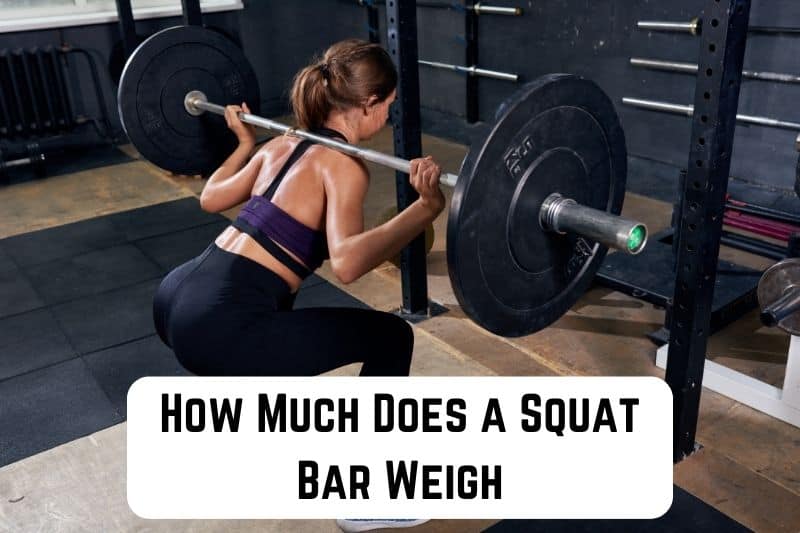When starting a weightlifting journey, it’s essential to know the basics. One common question you may have is, “How much does a squat bar weigh?” Understanding the weight of a squat bar can help you determine the additional weight needed for your workout and prevent potential injuries.
Squat bars, or barbells, come in various sizes and weights. Choosing the appropriate squat bar for your fitness level and goals is essential.
Read: How Much Does a Gallon of Honey Weigh? (Detailed Guide)
Standard barbells typically weigh around 45 pounds (20.4 kg) and are 7.2 feet (2.2 meters) long. However, there are also lighter and shorter variations, such as the 33-pound (15 kg) training barbell or the 15-pound (6.8 kg) technique bar.
What is a Squat Bar?
A squat bar, or barbell, is a piece of weightlifting equipment designed to help you perform squats effectively and safely. The barbell is a long metal bar that you place on your shoulders, holding it with both hands.
You then perform a controlled squatting motion to work out your lower body, mainly targeting your quadriceps, hamstrings, glutes, and core muscles.
You’ll typically find squat bars in gyms and fitness facilities, a staple in strength training programs. They come in various lengths and weights, which is important to consider when choosing the appropriate squat bar for your fitness level and training goals.
Some of the most common types of squat bars include:
- Standard Barbell: A standard barbell is usually around 7 feet long and weighs approximately 20 kilograms (44 pounds). This is the most common type of squat bar in a gym setting and is suitable for most lifters.
- Short Barbell: A short barbell is a more compact version, typically 5 or 6 feet long, and weighs around 15 kilograms (33 pounds). These bars are ideal for those with limited space or prefer a lighter bar for their squats.
- Specialty Barbell: Specialty barbells are designed to address specific lifting goals, such as safety squat or buffalo bars. These bars have unique shapes and features, allowing for alternative squatting techniques and positions.
As you work with a squat bar, always prioritize proper form and safety. This includes warming up, using a power rack or squat stand if available, and seeking guidance from a trainer or fitness professional when needed.

Standard Weight of a Squat Bar
Men’s Squat Bar Weight
At the gym, the standard weight of a men’s squat bar usually hovers around 45 pounds (20.4 kilograms). This weight is consistent across many Olympic-sized bars, commonly used for squats, bench presses, and other weightlifting exercises.
Knowing the bar’s weight is essential when calculating your total lifted weight. For example, if you squat with a 45-pound bar and have added two 45-pound plates (one on each end), your total lifted weight would be 135 pounds.
Women’s Squat Bar Weight
The standard weight for women’s squat bars is usually a little lighter, at 33 pounds (15 kilograms). These bars are thinner in diameter, making them easier for smaller hands to grip comfortably. As with men’s bars, the weight may vary slightly depending on the manufacturer and style.
Don’t forget to factor in the women’s bar weight when calculating your total lifted weight. So, if you squat with a 33-pound bar and have added two 25-pound plates (one on each end), your total lifted weight would be 83 pounds.
Factors Affecting Squat Bar Weight
When finding the perfect squat bar for your workouts, the bar’s weight can make a significant difference. In this section, we’ll explore the factors that affect the weight of a squat bar, including its material, length, and thickness.
Material
The material used to construct a squat bar directly impacts its weight. Most squat bars are made from steel, but the type of steel can vary.
- Standard steel: This is a common type of steel used in many squat bars. The density and durability of standard steel produce a bar that typically weighs around 20 to 25 kg (44 to 55 lbs).
- High-strength steel: Some manufacturers utilize high-strength steel, which is more resilient and allows for thinner bar diameters. This can result in a lighter squat bar, with weights ranging from 15 to 20 kg (33 to 44 lbs).
Length
The length of a squat bar also affects its weight. Longer bars require more material, making them heavier. Bar lengths typically fall into two categories:
- Standard length: Most squat bars have a standard length of about 7.2 ft (2.2 m). These bars generally weigh around 20 kg (44 lbs).
- Longer length: Powerlifting and specialty squat bars may be longer, reaching up to 8 ft (2.4 m) or more. These longer bars weigh 25 to 30 kg (55 to 66 lbs).
Thickness
The diameter of a squat bar plays a role in its overall weight. Thicker bars use more material, resulting in a heavier bar. Different thickness options include:
- Thin (25-28 mm): These bars are lighter and weigh as little as 15 kg (33 lbs), but may be less durable for heavier lifts.
- Standard (28-32 mm): Most squat bars, weighing around 20 kg (44 lbs), fall within this thickness range.
- Thick (32-35 mm): Heavier and more durable, these bars can weigh up to 25 kg (55 lbs) or more.
By considering a squat bar’s material, length, and thickness, you can select the one that best suits your needs and fitness goals. Just remember that each factor impacts the overall weight of the bar, so find the right balance to ensure a comfortable and effective workout.

Why Squat Bar Weight Matters?
When you’re working out, it’s essential to know the weight of your squat bar. This way, you can accurately track the weight you’re lifting and make necessary adjustments to your training routine. Let’s explore why squat bar weight matters and how it can impact your fitness journey.
Firstly, knowing the precise weight of your squat bar helps you maintain proper form while exercising. Misjudging the weight can lead to incorrect posture and potential injuries. So, it’s vital to know the bar’s weight and adjust exercises accordingly to prevent straining your muscles and joints.
Secondly, tracking your progress is crucial to achieving your fitness goals. By knowing the weight of your squat bar, you can accurately measure your gains and improvements over time. This allows you to adjust your workout plan, set realistic goals, and stay motivated.
Additionally, different squat bars are designed for specific purposes. Some bars are better suited for beginners, while others cater to more advanced lifters. By understanding the weight of each squat bar, you can select the appropriate one that matches your skill level and goals.
Lastly, knowing the squat bar’s weight can help you improve your training efficiency. You’ll need to lift heavier weights over time to increase muscle mass or improve your endurance.
Having a clear picture of your squat bar weight allows you to make necessary adjustments to your routine as you progress, ensuring you stay on track to reach your objectives.
Different Types of Squat Bars
When it comes to squat bars, you might be surprised to find out that there are several types available. This section will briefly discuss two main categories: Specialty Squat Bars and Olympic Squat Bars.
Read: How Much Does 3 Liters of Water Weigh? (Answer Revealed)
Specialty Squat Bars
These bars are designed specifically with squats in mind. They cater to various forms of exercise and can help address specific training needs. Here are some popular specialty squat bars:
- Safety Squat Bar: This bar has a unique design with padded shoulder support and handles, making it easier on your upper back and shoulders. They usually weigh around 20-30 kg (45-65 lbs).
- Cambered Squat Bar: This bar has a slight curve to distribute weight differently across your shoulders. The cambered squat bar reduces pressure on your spinal area and is perfect for athletes with limited shoulder mobility. It typically weighs 20-25 kg (45-55 lbs).
Olympic Squat Bars
These bars are the standard choice for professional weightlifting competitions and gyms. There are two main types of Olympic squat bars:
- Men’s Olympic Bar: The standard men’s Olympic bar measures 7.2 ft (2.2 meters), with a diameter of 1.1 inches (28mm). It is designed to hold a maximum weight of 700-1100 lbs (317-500 kg) and usually weighs around 20 kg (44 lbs).
- Women’s Olympic Bar: The standard women’s Olympic bar is slightly shorter, measuring 6.6 ft (2.01 meters), with a diameter of 0.98 inches (25 mm). It is designed to hold a maximum weight of 550-750 lbs (250-340 kg) and usually weighs around 15 kg (33 lbs).
When choosing a squat bar for your workout, consider your fitness goals and preferences. Both specialty and Olympic squat bars have their unique advantages to help you enhance your squatting performance and reach your objectives.







